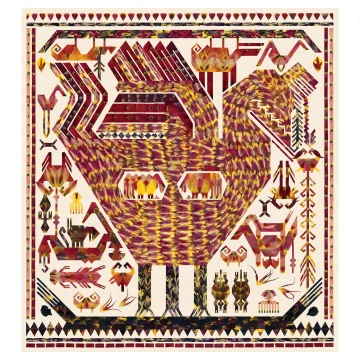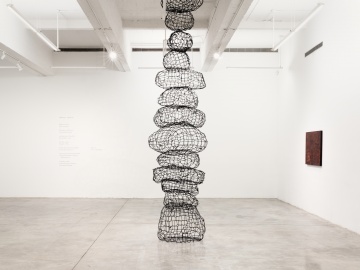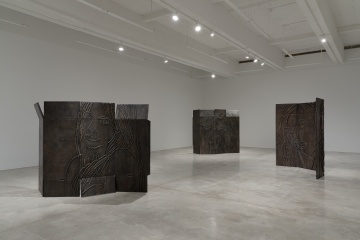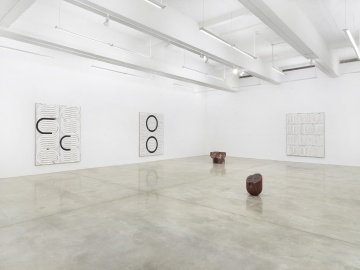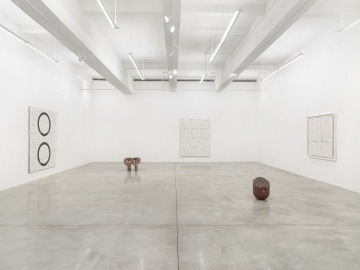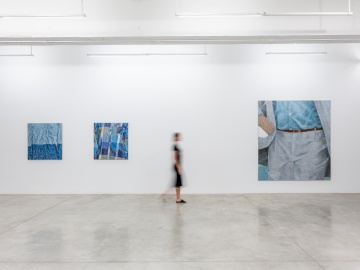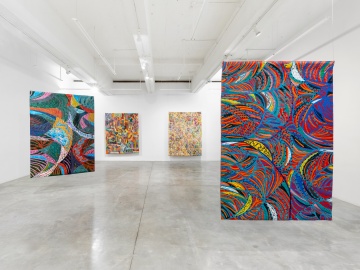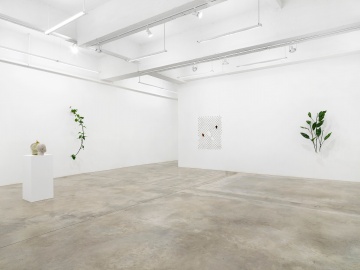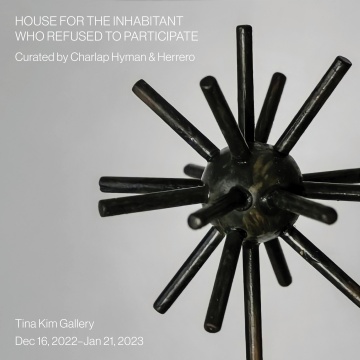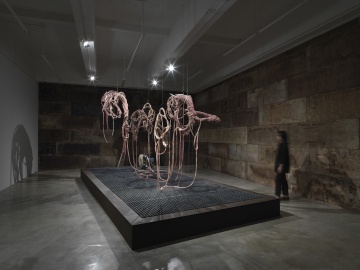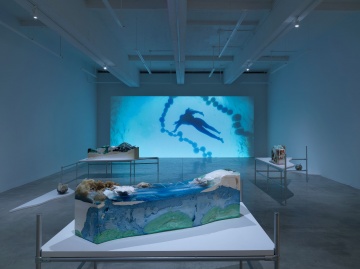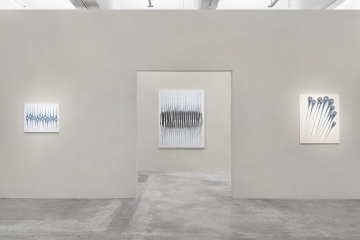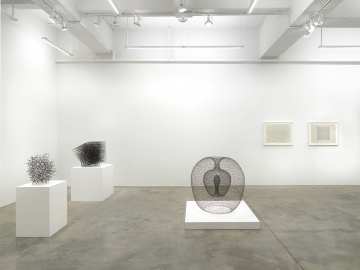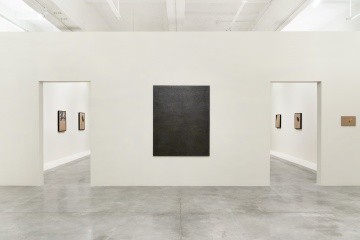Tina Kim Gallery
525 West 21st Street
New York, NY 10011
212 716 1100
New York, NY 10011
212 716 1100
Founded in New York in 2001 by Tina Kim and located in Chelsea, Tina Kim Gallery is celebrated for its unique programming that emphasizes international contemporary artists, historical overviews, and independently curated shows. With the gallery’s strong focus on Asian contemporary artists, Tina Kim has created a platform for important emerging and renowned women artists such as Minouk Lim, Wook-Kyung Choi, and Suki Seokyeong Kang, and has become a go-to destination for Korean contemporary and historical art. Through its programming, the gallery works closely with internationally renowned curators for special exhibitions and produces scholarly art publications.
Artists Represented:
CHUNG SEOYOUNG
CHUNG SEOYOUNG
DAVIDE BALLIANO
GHADA AMER
GIMHONGSOK
HA CHONG-HYUN
KIBONG RHEE
KIM TSCHANG-YEUL
KIM YONG-IK
KWON YOUNG-WOO
LEE SEUNG JIO
MINOUK LIM
MIRE LEE
PARK CHAN-KYONG
PARK SEO-BO
SUH SEUNG-WON
SUKI SEOKYEONG KANG
TANIA PÉREZ CÓRDOVA
WOOK-KYUNG CHOI
PACITA ABAD
Works Available By:
LEE UFAN
LEE UFAN
LOUISE BOURGEOIS
JOHN PAI
MINORU NIIZUMA
CHUNG SANG-HWA
CHUNG CHANG-SUP
Cole Lu, Dean Sameshima, Lotus L. Kang, Maia Ruth Lee, and Tosh Basco
Revolt of the Body
December 14, 2023 - February 3, 2024
Tina Kim Gallery is pleased to present ‘Revolt of the Body’ curated by Simon Wu, opening on Thursday, December 14th, 2023. Participating artists include Cole Lu, Dean Sameshima, Lotus L. Kang, Maia Ruth Lee, and Tosh Basco.
‘Revolt of the Body’ explores conceptions of flesh, sexuality, and time that precede modern and contemporary ideas of identity and self, borrowing its name from the final solo performance of Japanese choreographer Tatsumi Hijikata (1926-86). Taking place at Tokyo’s Nihon Seihan hall in October 1968, “Revolt of the Body” was Hijikata’s most intense articulation of Ankoku Butoh, an avant-garde movement practice he founded nine years earlier, literally denoting ‘dance of darkness.’ Hijikata sought to re-invent the boundaries of art, life, and humanity in the shadow and devastation of World War II.
While the artists do not explicitly cite Hijikata, their works invoke alternative, rebellious bodies in line with Butoh’s historic provocations. The radically recombinant body is typefied in Dean Sameshima’s Erotic Dot Series––fields of connect-the-dot paintings that make images of gay sex when connected as prescribed, or something else alien, unrecognizable, if you choose your own paths. In Cole Lu’s sculptures, etchings and drawings, he produces mythic images of celestial and premodern lives. Flesh is reimagined as wirey, ghostly baskets in Maia Ruth Lee’s social sculptures––assembled as a singular column like an arm or a body––and as bruisable, photosensitive surfaces in Lotus L. Kang’s drawings. And as in Tosh Basco’s hand prayer drawings, each of them are a kind of flesh in themselves.
Ghada Amer
Paravent Girls
October 26, 2023 - December 9, 2023
Tina Kim Gallery is pleased to announce Ghada Amer: Paravent Girls, a solo exhibition of groundbreaking new works by Cairo-born, New York-based Ghada Amer (b. 1963). A pioneering feminist artist of the post-colonial generation, Amer is considered a force to be reckoned with, advocating for female agency and empowerment in the current contemporary art landscape. This exhibition marks the debut of her monumental sculptures—collectively entitled the Paravent Girls—in New York. Commissioned for her major career retrospective that took place across three venues in Marseille, France (2022), three of the largest scale sculptures included were displayed under the rotunda of the historic chapel of the La Vieille-Charité (a former house of charity and asylum). The works that will be on view at Tina Kim Gallery are a culmination of the artist’s years of experimentation and research. Amer’s sculptural journey began with ceramics before its manifestation in bronze; these new works signal a veritable breakthrough in her artistic trajectory.
Ghada Amer has been committed to exploring issues surrounding women– the politics of their representation and their cross cultural perception. Amer’s wide-ranging, daring art practice that spans over three decades, is unrestricted by medium. She is equally at ease with two-dimensional works on canvas or paper, ceramics, site-specific garden works, and mixed-media installations. Many works in Amer’s oeuvre begin with female nude images appropriated from pornographic magazines. While typically viewed as a vehicle for male pleasure, Amer’s works transform them into emblems of women in states of euphoria, ecstasy, and liberation. Although seemingly anonymous, several female subjects depicted in the Paravent Girls bear identifiable names; for example, Suzy Playing, Jennifer and Barbara, and L'étonnement d’ Amélie (all 2022). Amer begins by painting these figures onto the unfolded surfaces of discarded cardboard boxes, before transferring these portraits into clay, redrawing each of their features in relief. The clay models are cast, eventually realized as bronze sculptures. Amer’s tactile approach is reflected in the raised ridges of the outline across the surface that reveal the imprint of the artist’s hand. A quality of tenderness is brought to light upon close examination.
Titled the “Paravent Girls,” this series exemplifies Amer’s long-standing concern regarding the gaze and the power dynamics at work in the act of looking. Paravents, or “folding screens,” were utilized as privacy devices, often used to conceal an (undressing) woman from view. Mass media have often portrayed screens in scenes of flirtation, seduction, or even outright violations of privacy. Thus, Amer’s primary material of unfolded cardboard boxes serve as a visual metaphor to these screens, calling attention to the roles of the viewer and the viewed. In the Paravent Girls, the female figure is depicted on both sides of the sculpture, as if to defy conservative notions of modesty. As art historian and scholar Isabella Archer remarks:
Making bronze sculptures is both symbolic and significant. After all, bronze, sturdy and imposing, is the metal of choice for statues that are made to face the elements as well as the test of time. Monuments and memorials to history, people, places, and allegories are often recorded in bronze in public spaces around the world. [...]
The confidence of Amer’s girls, smiling and playing as they dress or undress themselves and the other, belie the nature of the paravent and recall its humble origins—a cardboard box, a porn magazine—that are given weight and permanence when cast in metal.
Davide Balliano
Event Horizon
September 7, 2023 - October 7, 2023
An event horizon is the edge of a mystery. It cuts a boundary between what can and cannot be known. And here in the interstice Davide Balliano opens novel territory in his paintings and sculptures for the flinty visual tropes he has been developing for nearly a decade. His vocabulary of images and techniques and the ideas that they encapsulate find new striking resonances across time and space. Forms that recur through the plane of paintings are also found in sculptures but in both they are ever unexpectedly terminated and hang mesmerically in a realm between apotheosis and schism.
The facture of Balliano’s paintings produces visual geology. And yet the artist’s hand appears and vanishes. [1] While the precision could be read as austere and mechanical, the works have delicate surfaces that breathe and drip. They oscillate. Even the sparest black painting, Untitled_0269, is vibrating with the fine concentric and almost monochromatic circles of its major theme and also with the diffracting marks of its small details. [2] Images like Untitled_0269 and its polar opposite, bright white Untitled_0267, are visibly conceived as snippets of a larger continuum. Their ribbony patterns repeat and are interrupted on the canvas, but their presumed extension beyond its edges is undefined. They respond to gravity. They radiate into space beyond the canvas while they drip downward toward Earth. Balliano’s rolling waves and thrumming concentric circles are sometimes interrupted by discordant breaks in an established pattern. Untitled_0247 and Untitled_0270 shatter. They change color and are bisected. (Information about where and how Balliano's paintings are strictly controlled or subject to aleatory influences—the unfurling of matte black, white, and crepuscular gray—is veiled beyond a certain limit.) Untitled_0247 wavers like a jittering transmission from deep space. His sinusoidal bands are nonetheless rescrescent. Peaks and troughs expand across the canvas and out. As with emanations across time and space and through birthing galaxies or from abandoned archaeological ruins, we can know almost nothing of them beyond their edges but that they continue. They might be imagined as diagrams of gravity waves from the early Universe. Such histories as drafted by astrophysicists are so distant and large and speculative as to be abstractions. And although Balliano's paintings might prosaically resemble the emergence of order from chaos in the Universe’s fundament by the primogenial collision of supermassive black holes, they are of themselves and are crafted by the artist alone.
Four new monolithic marble sculptures rise from the floor to greet their two-dimensional counterparts. [3] They resemble an impenetrable inhuman satellite or the displaced menhir of a forgotten neolithic civilization and their scale is more commanding than their size suggests. Their context is Balliano’s exploration of visual and dimensional form. But they speak to ages before and to come. Balliano's earlier work tended to very deep relief and into the domain of sculpture. The stones here fully inhabit that space: images in the round. The stones' material echo Balliano's painting process with their hidden but interpretable origins inside the planet. Cutting and polishing may reveal mineral facets that have not been exposed since the Earth was a primordial orb newly formed in the Universe. Their juxtaposition with the paintings may cast those latter artworks now as cultic esoterica rather than transmissions from distant worlds.
The undulating meanders of Balliano's paintings are rendered dimensional in Untitled_Rosso Agadir and Untitled_Nero Marquinia. (The sculptures are titled for the ancient names of the marble varieties.) Both use a form of two scooping U-shaped concavity. Each stands on two feet, the former on stilts and the latter standing on two mere suggestions and elevated by a concrete foundation. The paintings’ U motif is expanded into something resembling an exedra or atavistic throne. They are archaic and call to forms repeated through art’s antecedents back into ashy hominid cave paintings in prehistory. Their mineral inclusions of flowing white calcite and jet-black stylolites resemble the paintings' contingent drips and scratches. What was transformed first by the eonic processes of geology was selected and altered for the expression of something beyond the terrestrial. They are history ossified. And their refined rendering, like his careful painting, exudes tenderness.
The veins and stippling of Untitled_Rosso Laguna 1 and 2 draw closer to flesh. Ribbony geometries are supplanted by two bolluses resting on rounded bottoms. The archetypal U repeats inwardly and outwardly like a tesseract or other hyperspatial solid before the forms’ smooth and polished surfaces are unexpectedly dramatically broken. Rosso Laguna 1 is complexly layered with small beads carefully spaced in a grid across its surface. It resembles the Egyptian antiquity, Fragment of the head of a queen, even to the philtrum-like scalloping rolling down the face of the rock. And it is similarly broken off at the head. Untitled_Rosso Laguna 2 opens like a geode. Its smooth exterior is cleft to disclose a background field of sparkling rock. And within is a sanctum. It is a manmade basin as would be used in another time for anointments or holy offerings to a deity now forgotten or alien to this realm.
Davide Balliano is a summoner. He recombines simple substances into complicated images. His inquisitions are deft and increasingly focused. There are boundaries that cannot be seen past but he calls through long time and space to illuminate those borders.
- Noah Dillon
Davide Balliano
Event Horizon
September 7, 2023 - October 7, 2023
An event horizon is the edge of a mystery. It cuts a boundary between what can and cannot be known. And here in the interstice Davide Balliano opens novel territory in his paintings and sculptures for the flinty visual tropes he has been developing for nearly a decade. His vocabulary of images and techniques and the ideas that they encapsulate find new striking resonances across time and space. Forms that recur through the plane of paintings are also found in sculptures but in both they are ever unexpectedly terminated and hang mesmerically in a realm between apotheosis and schism.
The facture of Balliano’s paintings produces visual geology. And yet the artist’s hand appears and vanishes. [1] While the precision could be read as austere and mechanical, the works have delicate surfaces that breathe and drip. They oscillate. Even the sparest black painting, Untitled_0269, is vibrating with the fine concentric and almost monochromatic circles of its major theme and also with the diffracting marks of its small details. [2] Images like 0269 and its polar opposite, bright white Untitled_0267, are visibly conceived as snippets of a larger continuum. Their ribbony patterns repeat and are interrupted on the canvas, but their presumed extension beyond its edges is undefined. They respond to gravity. They radiate into space beyond the canvas while they drip downward toward Earth. Balliano’s rolling waves and thrumming concentric circles are sometimes interrupted by discordant breaks in an established pattern. Untitled_0247 and Untitled_0270 shatter. They change color and are bisected. (Information about where and how Balliano's paintings are strictly controlled or subject to aleatory influences—the unfurling of matte black, white, and crepuscular gray—is veiled beyond a certain limit.) 0247 wavers like a jittering transmission from deep space. His sinusoidal bands are nonetheless rescrescent. Peaks and troughs expand across the canvas and out. As with emanations across time and space and through birthing galaxies or from abandoned archaeological ruins, we can know almost nothing of them beyond their edges but that they continue. They might be imagined as diagrams of gravity waves from the early Universe. Such histories as drafted by astrophysicists are so distant and large and speculative as to be abstractions. And although Balliano's paintings might prosaically resemble the emergence of order from chaos in the Universe’s fundament by the primogenial collision of supermassive black holes, they are of themselves and are crafted by the artist alone.
Four new monolithic marble sculptures rise from the floor to greet their two-dimensional counterparts. [3] They resemble an impenetrable inhuman satellite or the displaced menhir of a forgotten neolithic civilization and their scale is more commanding than their size suggests. Their context is Balliano’s exploration of visual and dimensional form. But they speak to ages before and to come. Balliano's earlier work tended to very deep relief and into the domain of sculpture. The stones here fully inhabit that space: images in the round. The stones' material echo Balliano's painting process with their hidden but interpretable origins inside the planet. Cutting and polishing may reveal mineral facets that have not been exposed since the Earth was a primordial orb newly formed in the Universe. Their juxtaposition with the paintings may cast those latter artworks now as cultic esoterica rather than transmissions from distant worlds.
The undulating meanders of Balliano's paintings are rendered dimensional in Rosso Agadir and Nero Marquinia. (The sculptures are titled for the ancient names of the marble varieties.) Both use a form of two scooping U-shaped concavity. Each stands on two feet, the former on stilts and the latter standing on two mere suggestions and elevated by a concrete foundation. The paintings’ U motif is expanded into something resembling an exedra or atavistic throne. They are archaic and call to forms repeated through art’s antecedents back into ashy hominid cave paintings in prehistory. Their mineral inclusions of flowing white calcite and jet-black stylolites resemble the paintings' contingent drips and scratches. What was transformed first by the eonic processes of geology was selected and altered for the expression of something beyond the terrestrial. They are history ossified. And their refined rendering, like his careful painting, exudes tenderness.
The veins and stippling of Rosso Laguna 1 and 2 draw closer to flesh. Ribbony geometries are supplanted by two bolluses resting on rounded bottoms. The archetypal U repeats inwardly and outwardly like a tesseract or other hyperspatial solid before the forms’ smooth and polished surfaces are unexpectedly dramatically broken. Rosso Laguna 1 is complexly layered with small beads carefully spaced in a grid across its surface. It resembles the Egyptian antiquity, Fragment of the head of a queen, even to the philtrum-like scalloping rolling down the face of the rock. And it is similarly broken off at the head. Rosso Laguna 2 opens like a geode. Its smooth exterior is cleft to disclose a background field of sparkling rock. And within is a sanctum. It is a manmade basin as would be used in another time for anointments or holy offerings to a deity now forgotten or alien to this realm.
Davide Balliano is a summoner. He recombines simple substances into complicated images. His inquisitions are deft and increasingly focused. There are boundaries that cannot be seen past but he calls through long time and space to illuminate those borders.
- Noah Dillon
Kang Seok Ho
Deep is the rising sun, far is the falling one
June 29, 2023 - August 11, 2023
Tina Kim Gallery is pleased to announce Deep is the rising sun, far is the falling one, the first New York solo exhibition of Kang Seok Ho (1971-2021). Upon receiving his Bachelors of Fine Art in sculpture at Seoul National University, Kang Seok Ho left for Germany to study with Jan Dibbets (b. 1941) at the Kunstakademie Düsseldorf, where he received his Masters of Fine Art in painting. Kang Seok Ho is an artist who investigates and probes the medium of painting through the simple and everyday premise around the act of “seeing.” For example, in his 2006 solo exhibition at Kumho Museum of Art in Seoul, he exhibited over forty paintings that repeatedly depicted an image taken from a photograph showing the backside of someone wearing a checkered green jacket with their hands clasped behind them. For Kang, painting begins with an interior meditation on the question of how to approach and portray subject matter, rather than a question regarding its content.
When Kang returned to Korea in the early 2000s, the Korean art scene at that time was defined by a multimedia, postmodern, socio-political aesthetic, leaning heavily into a post-genre and post-medium “anything goes” tendency.[1] Kang Seok Ho did not pay attention to nor become wrapped up in this mindset. Despite the advent of digital cameras and the overflow and saturation of digital images, Kang chose to focus on examining the relationship between the image and the act of its portrayal, and how to widen the distance between those two entities. Through admiring the attitudes of masters such as Piero della Francesca, Giorgione, Tintoretto, Titian, and Giorgio Morandi, Kang independently explored more traditional subject matter such as figurative, landscape, and still-life paintings, as well as other themes involving time and space.
This exhibition focuses on Kang’s “Get Up” series, which marks Kang’s investigations in painting that first began in Germany and continued until his untimely death in 2021. Initially prompted by a drawing Kang did in 1999 of his friend’s sweater while sitting across from each other at a cafe, these works are based on photos Kang took, then cut, re-angled, and enlarged on the canvas. Kang excluded narrative features such as a person’s face and the surrounding background, and focused rather on formal details such as color, pattern, texture, and wrinkles of fabric as they move along the curves of the body, creating a unique visual language. In the “Get Up” series, which previously focused on depicting the figure’s frontal side, Kang started to deal with the back of the figure after the year 2000. Inspired by the actors sitting with their backs to the camera in the film of Michelangelo Antonioni, Kang Seok Ho felt a strange and unfamiliar discomfort that he simultaneously alleviated and revealed in the pictorial realm, finding this to be an interesting subject matter. The back of a woman with long curly hair reminiscent of a waterfall in a valley, or the focus on depicting color and texture of fabric like a “dry bamboo leaf” all reveal Kang’s attitude that closely mimics the philosophy of traditional Asian landscape painters. In reference to his own paintings of white trousers and denim pants, he has alluded to white porcelain or rocky landscapes, meaning that he thought of his work as being closer to landscape rather than portraiture.[2] Furthermore, Kang Seok Ho placed great emphasis on the methodologies involving surface preparation as well as brushwork. When considering the absorbency of paint, he was particular about the type of linen he used, and he devised a method of layering thinned paint several times on the surface. The brush strokes serve to reveal and resemble the weaving and materiality of the canvas more than showing the colors or shapes depicted on it. On the canvas where one encounters the physicality of his brushstrokes pressed and rubbed with color, representation and description feel far from his intent. While Kang’s work may fit into the category of realism, the sense of transparency where light and air seems to flow and move without constraint is emblematic of Kang’s distinct aesthetic and his sense of lyricism in the everyday.
“That starts with just seeing. I have a penchant for the act of seeing.”
The artist’s research on the act of seeing is further revealed in his series of drapes. While drapes are usually hung over windows covering the view, they also become stand in’s, replacing the outside scenery. The drapes that the artist looks at form a horizon line along the simple color, pattern, and fabric of the canvas, transforming into the image itself. An image that does not seem to convey a direct message ultimately leads the viewer to keep returning to it, pondering the painting and the artist’s vision. In the case of his “Couple Series,” which shows a close-up of one eye from two people, it is the image that looks at the viewer, simultaneously interrogating and responding to them. In addition, his black and white “Gesture” series captures the gestures of politicians and athletes exposed to the media. His “Nude” series focuses on various skin tones and textures, as well as a still life study of stationary objects, and builds up to his “Cube” series. Kang Seok Ho’s representative painting series are all an attempt to experiment with and discover a new approach to the unique structure and confines of the genre of painting.
The title of this exhibition “Deep is the rising sun, far is the falling one” was the subtitle of Kang Seok Ho’s essay “The Second Hiking.”[3] The descriptions of his daily climbing route of Namsan Mountain, where the traces of soil are neatly swept and the colors of the light and sunset shine through the pine trees and the forest, are not too different from the experience of viewing Kang’s paintings. Since Kang Seok Ho’s attitude towards the everyday is inextricably linked to the aesthetic characteristic of his paintings, his writings that record his daily life serve as an important foundation for understanding his inner world.
Pacita Abad
Colors of My Dream
May 18, 2023 - June 17, 2023
Tina Kim Gallery is pleased to announce its first major solo exhibition of Pacita Abad (1946-2004), a Filipina-American visual artist. Including paintings from important private collections as well as from the Pacita Abad Art Estate, this solo presentation will be the first in New York City devoted to the artist. Spotlighting Pacita’s abstract body of work created between 1985 and 2002, this exhibition offers a close look at the development of a vibrant and distinctive style as she pushed the traditional boundary of painting over the course of her 32-year career. Pacita’s oeuvre was informed by her itinerancy and deep engagement with and awareness of issues of globalization, transnationalism, and migration. Incorporating materials and techniques from Manila, Seoul, and Jakarta, the works in this exhibition highlight Pacita’s travels across Southeast Asia. This presentation simultaneously considers her use of color and material ornamentation as a strategy of resistance against the homogenizing modernist paradigm, while forging a transcultural solidarity.
Born in Batanes, Philippines to politically engaged parents, Pacita Abad settled in the United States in the 1970s, forced to flee after leading student demonstrations against the Marcos regime, subsequently beginning what would be a prolific artistic career. While living in Boston in 1981, Pacita was introduced to the trapunto by her friend Barbara Newman, a doll-maker, and continued to explore and transform this technique. Pacita painted, stitched, padded, and embellished unstretched canvases to create a dimensional object with expanded surface and portability, allowing for fluid and spontaneous artistic experimentation. Her trapuntos translate lived experience by incorporating indigenous materials, ranging from Rabari mirrored embroidery from India, bark cloth from Papua New Guinea, huipils from Guatemala and Mexico, and batik and ikat from Indonesia, forming what Stanka Radovic terms “a living tapestry of places.” Pacita Abad lived on seven continents and traveled to over sixty countries, which led to the encounter and absorption of global textile traditions and techniques.
Fully displaying her painterly sophistication, Pacita’s abstractions developed concurrently with her figurative works.
Her “tropical aesthetic” and ornamental lexicon serve to activate the political possibility of abstraction. As a woman of color whose life was often in transit but whose vision was global, Pacita cannot be easily balkanized into a singular category. In Fresh Talk/Daring Gaze, Faith Ringgold points out that Pacita’s sense of coloration augments the visibility of both her work and person and relates it to the experience of sexism and racism faced by the racial others. Viewed through such lens, color is the thread that connects the various cultural, economic, and historical peripherals and a way of standing with diasporic or marginalized communities. Pacita’s abstractions transmute cultural specificity into collectivity, inverting the mechanics of marginalization while carving out a new space in which cultures, identities, and materialities may intersect and form new meanings.
The solo exhibition takes place concurrently with a major traveling retrospective at the Walker Art Center in Minneapolis, curated by Victoria Sung with assistance from Matthew Villar Miranda. The retrospective will travel to San Francisco Museum of Modern Art; Art Gallery of Ontario, Toronto; and MoMA PS1, New York. Abad’s works are in the permanent collection of Tate Modern, M+ Hong Kong, National Gallery Singapore, National Museum of Women in the Arts, Walker Art Center, and major institutions around the world.
Maia Ruth Lee
The skin of the earth is seamless
April 6, 2023 - May 6, 2023
New York, New York — Tina Kim Gallery is pleased to present The skin of the earth is seamless, a solo exhibition of works by Busan-born, Colorado-based artist Maia Ruth Lee (b. 1983). For her first exhibition with the gallery, Lee debuts a series of paintings, sculptures, and video, all developed over the course of the past year. These works expand on Lee’s Bondage Baggage series (2018-ongoing), born out of the artist’s longstanding concerns surrounding the physical, psychological, and emotional experiences of a diasporic migratory life. The works included in the exhibition speak to the potentiality of healing and transformation that could take place despite or rather, through mobility and rootlessness. Through abstraction, Lee’s work fluctuates between states of being settled and states of change.
All works presented in this exhibition stem from a material process that is at once tactile and painterly. The Bondage Baggage sculptures were originally developed in reference to the luggage seen on conveyor belts at the international airport in Kathmandu, where the artist spent her childhood. As objects that witness and endure limitations of physical borders, the parcels appear to the artist as containers of stories and ideas. Linen, clothing, and used materials are bunched together, covered with plastic, tarps, burlap or canvas, then meticulously fastened with rope-like cord in order to create the sculptures. The soft surfaces of these bundles often bulge and strain, evoking the fundamentals of containment and constraint, but also that of fortitude and resilience. Installed throughout the galleries, the physical qualities of these works evince notions of self-preservation, protection, and manifestation.
Some Bondage Baggage sculptures do not remain in these forms. The canvas layer of the sculptures is painted in ink and left to seep around and through the ropes. These ropes are then cut, allowing the “skin” of the sculptures to be unfurled, revealing Lee’s Bondage Baggage paintings. Summoning the appearance of leather or aging skin, each painting reveals track-like imprints that evidence the act of bondage performed on it previously. Although creases and traces are visible, they maintain an energetic, almost entropic charge. Often structured as burst-like compositions, the paintings seemingly radiate from an internal center outward. Describing these works as “vital embodiment of change, mutation, and growth,” the artist has conceptualized these paintings as visceral expressions of expansion and aliveness. These paintings stand in contrast to the second sculptural series on view: empty, shell-like “pods” that are suspended and scattered within the gallery space. Made from the discarded ropes cut away from the body of the original Bondage Baggage sculptures, these works can be seen as the exoskeletal structure shed during the work’s metamorphosis. Remaining as fragile subjects, they bear only the vestiges of the items they once served to protect.
The exhibition’s title refers to a quote in writer Gloria Anzaldúa’s 1987 text “Borderlands/La Frontera”. Although Anzaldúa likens having a diasporic identity to having an open wound, she writes that “the skin of the earth is seamless, the sea cannot be fenced, el mar does not stop at borders.” In “The Letter”, a new video that Lee made for the exhibition, she stitches together footage of old family videos shot by her father in her rural hometown of Nepal. Subtitled with text from Lee’s personal letters written between 2020 through 2022, the seemingly mundane moments captured in the video provoke questions and concerns surrounding the home, family, spiritual inheritance, language, and translation. A tender and poignant portrait of one’s interior self, the exhibition centers migration as a generative, powerful force for creation.
Maia Ruth Lee has held solo exhibitions at the Museum of Contemporary Art Denver (CO), Francois Ghebaly Gallery (LA), and Jack Hanley Gallery (NY). Lee has participated in numerous group exhibitions including the Aspen Art Museum (CO), 2019 Whitney Biennial, Whitney Museum of American Art, Helena Anrather Gallery, CANADA gallery, Studio Museum 127, Salon 94 in New York, and Overduin & Co. Gallery, and Roberts & Tilton Gallery in Los Angeles. Lee attended Hongik University in Seoul, and the Emily Carr Institute of Art and Design in Vancouver, Canada. Lee was the recipient of the Gold Art Prize in 2021 and the Rema Hort Mann grant in 2017. Her work is held in the public collection at the Whitney Museum of American Art.
Tania Pérez Córdova
Precipitation
February 2, 2023 - March 25, 2023
New York, NY — Tina Kim Gallery is pleased to announce Tania Pérez Córdova: Precipitation, opening February 2. This is the second show of the artist’s to be held at the gallery, and coincides with her solo exhibition currently ongoing at the Museo Tamayo, Mexico City. Incorporating within her practice sculpture, found objects, and activation or performance, Pérez Córdova is recognized for her poetic and contemplative works that often bear narrative implications. Born and based in Mexico City, Pérez Córdova’s practice is distinguished by its provisional nature—both in its process of making, but also in its reception. Although she often works with conventional materials such as metal, glass, ceramics, and marble, Pérez Córdova allows chance encounters in everyday life (for example, coins gathered in the bottom of a friend’s pocket, or a meeting with a street musician) to inspire or influence the outcome of the works themselves. As a result, the artist integrates unorthodox materials—including found objects, detritus, clothing, jewelry, amongst others—into the works themselves. Presented in the context of an exhibition, her works frame relationships between objects and narratives, pointing towards situations or events that may have happened outside the space of the gallery.
Precipitation features two new bodies of work: a series of sculptures developed using artificial leaves, and another of blown glass that references the rhythms of breathing patterns. In the first, the appearance of the lush, green leaves are disrupted by their punctured and torn surfaces, patterned to resemble that of insect infestations, or botanic infections. Adorned with jewelry chains falling from the ceiling, these works evoke an affect that lies in between alluring and unnerving. The positioning of their chains draw from rainfall patterns—drizzles, showers, and storms—in the density of their arrangements, as though inviting viewers to imagine a singular meteorological event. Seen together, the works present an imaginary of a verdant landscape; yet, they simultaneously hint at an abstract, discomforting presence that is revealed upon close inspection. Accompanying this body of work are a group of blown glass sculptures, which are interspersed throughout the gallery’s space. Inspired by the notion that different patterns of breathing can induce different psychological states, these sculptures are presented as containers for the human breath. Pérez Córdova’s works thus invite viewers to read into the scenarios implied by the formal appearances and mediums of the works themselves. Collectively, the works evince the artist’s lyrical approach to art-making that moves seamlessly between object, personal biography, and conjured imaginaries. They ask viewers to read personal or general meaning into each object, allowing for speculation to become part of the experience of the exhibition itself.
ABOUT THE ARTIST
Born in 1979, Tania Pérez Córdova lives and works in Mexico City. Her work has been the subject of several solo exhibitions, including at the Museo Tamayo Arte Contemporaneo, Mexico City (2022), Kunsthalle Basel, Basel (2018), and the Museum of Contemporary Art in Chicago (2017), amongst others. She has also exhibited in numerous group shows within an institutional context, including the Aichi Triennale (2019), SITE Sante Fe (2018), the Gwangju Biennale (2016), the New Museum Triennial (2015), and the Shanghai Biennale (2012). Her work can be found in public collections including the SFMoMA, San Francisco; MCA Chicago; Museo Tamayo, Mexico City; and the Colección Patricia Phelps de Cisneros.
ABOUT TINA KIM GALLERY
Founded in New York in 2001 by Tina Kim and located in Chelsea, Tina Kim Gallery is celebrated for its unique programming that emphasizes international contemporary artists, historical overviews, and independently curated shows. With the gallery’s strong focus on Asian contemporary artists, Tina Kim has become a leading figure in introducing the Korean Dansaekhwa art movement to the American audience. Furthermore, she has created a platform for emerging and renowned artists such as Lee Seung Jio, Pacita Abad, Kim Tschang-Yeul, Tania Pérez Córdova, Minouk Lim, Davide Balliano, and Suki Seokyeong Kang. Through its programming, the gallery works closely with internationally renowned curators for special exhibitions and produces scholarly art publications.
Louise Bourgeois, Heidi Bucher, Sam Chermayeff, John Hejduk, Camille Henrot, James Hone, Ficus Interfaith, Anne Libby, Mathieu Matégot, Emma McCormick-Goodhart, Pietro Melandri, Luke O'Halloran, Eli Ping, Steph Shiu, Sophie Stone, Kim Tschang-Yeul, Luc Tuymans
House for the Inhabitant Who Refused to Participate
December 16, 2022 - January 21, 2023
House for the Inhabitant Who Refused to Participate
Curated by Charlap Hyman & Herrero
December 16, 2022 - January 21, 2023
New York, NY — Tina Kim Gallery is pleased to present “House for the Inhabitant Who Refused to Participate,” an exhibition of modern and contemporary art and design curated by New York / Los Angeles-based architecture and interior design firm Charlap Hyman & Herrero (CHH). “House for the Inhabitant Who Refused to Participate” will open with a public reception on December 16, 2022, from 6 PM to 8 PM and will continue until January 21, 2023.
The title “House for the Inhabitant Who Refused to Participate” is an homage to a project of the same name by the architect John Hejduk, a masterpiece of what he called “the architecture of pessimism.” The house is part of a trilogy of structures illustrating his proposition that humanity is trapped in the compressed, flattened realm of the moment—a counter to the early Modernists’ optimistic obsession with dynamism and the future. The pieces presented in the show partake in this exploration of the spatial quality of a singular instant.
Long shadows, rendered in two tones of felt, stretch unchanging across the floor of the room. John Hejduk’s ‘Cilia’ bed, at once containing “a dread and a sensuousness,” the solidification of an improper thought, draped in a beaded work by Steph Shui on which visitors are invited to recline; Eli Ping’s folded canvas ‘Monocarp’, suspended in a resin coating, flash frozen; Luke O’halloran’s radiating playing cards, caught in mid air; Mathieu Matégot’s 1960 woozy Tijuana sunset never fully setting; Camille Henrot’s gloves, slipped from an anonymous pocket, fixed in bronze; James Hong’s 1981 Tropic of Cancer table, the static remnants of a tidal shift; Anne Libby’s rippling reflection of one building on another, as if seen from the LA freeway...
“It’s here that you are confronted with the flattest condition. It’s also the quickest condition, the fastest timewise in the sense that it’s the most extended, the most heightened; at the same time, it’s the most neutral, the most at repose. In other words, it’s a point of slip-over, a place that you can’t anticipate or delay.” - Hejduk/Wall.
Staged specially for the exhibition’s opening reception, AMOC artists Anthony Roth Costanzo, countertenor, and Coleman Itzkoff, cellist, will perform “Ombra Mai Fu” by George Frideric Handel (from 1738) and “In Darkness Let Me Rest” by John Dowland (from 1610).
The exhibition brings together works by Louise Bourgeois, Heidi Bucher, Sam Chermayeff, John Hejduk, Camille Henrot, James Hong, Ficus Interfaith, Anne Libby, Mathieu Matégot, Emma McCormick Goodhart, Pietro Melandri, Luke O’Halloran, Eli Ping, Steph Shiu, Sophie Stone, Kim Tschang-Yeul, and Luc Tuymans.
By Chelsey Mitchell and Adam Charlap Hyman
ABOUT TINA KIM GALLERY
Located in New York, Tina Kim Gallery is celebrated for its unique programming that emphasizes international contemporary artists, historical overviews, and independently curated shows. Founded in 2001 by Tina Kim, it is noted for working closely with museums and institutions to expand the audience of its global roster of artists.
ABOUT CHARLAP HYMAN & HERRERO
Charlap Hyman & Herrero is an architecture and design firm that considers all aspects of the built environment, centering collaboration at the core of their practice. Working across a multitude of mediums, CHH endeavors to create spaces that become worlds unto themselves, from gardens to freestanding structures, theater sets to curated exhibitions.
SALE INQUIRES
inquiries@tinakimgallery.com | +1 (212) 716-1100
PRESS INQUIRES
Jillian Scott | Third Eye
jillian@hellothirdeye.com | +1 (212) 355-9009 x 313
Victoria Laboz | Third Eye victoria@hellothirdeye.com | +1 (212) 355-9009 x 314
Minoru Niizuma
Waterfall in Autumn Wind
November 10, 2022 - December 10, 2022
New York, NY — Tina Kim Gallery is pleased to announce its first exhibition dedicated to the practice of Japanese-American sculptor and educator Minoru Niizuma (b. 1930, Tokyo; d. 1998, New York). Recognized for his abstract marble sculptures in the postwar period, Niizuma exhibited widely in the United States and Europe, and was an active organizer of public sculpture exhibitions across both continents. Although a lifelong artist and educator whose works entered multiple institutional and private collections, Niizuma’s legacy has rarely been acknowledged since his passing at the age of 67, in part due to a lack of formal representation. Marking the first attempt to introduce a deeper understanding of the artist’s practice, the exhibition brings together works from two key decades of his practice—the 1970s and 80s. In addition, on view are a range of rare archival material that contextualizes his efforts to promote broader cross-cultural understandings between the US, Europe, and Japan through his stone-carving symposiums, exhibitions, and public sculpture parks. Accompanying this exhibition will also be an illustrated exhibition catalog, featuring an extended introduction of the artist written by art historian and curator Reiko Tomii. Born in Tokyo in 1930 and educated at the Tokyo National University of Fine Arts and Music, Niizuma immigrated to New York in 1959, and joined the Brooklyn Museum Art School as an instructor in 1964. Upon establishing his studio practice in New York, Niizuma attained the space needed to develop larger-scale sculptures; soon after, his work was included in both the 1966 and 1968 Whitney Annuals, as well as a landmark survey of Japanese Art that traveled through five institutions across the US, including the San Francisco Museum of Modern Art and the Museum of Modern Art, New York. Throughout his life, Niizuma worked in series, focusing on refining and iterating a single form over the course of several years.
Although affiliated with the emerging artistic cluster that came to become known as “Minimalism,” Niizuma’s artistic development remained intrinsically indebted to the properties of his oft-chosen mediums: marble and granite. Beginning from the 1970s and 80s onwards, Niizuma increasingly chose to execute his works in ways that revealed—rather than obviated—the natural appearance of stone, reacting against the prevailing emphasis on industrial material and processes dominating sculptural practice during that time. In contrast with his earlier work from the 1960s, which are often characterized by highly polished surfaces and geometric forms, the works included in the exhibition bear evidence of the artist’s intention to restrain his own hand. As exemplified by works such as Windy Wind (c.1970s), the surfaces of the sculptures are marked by grooves, crags, and furrows. Yet, the rough-hewn appearance of Niizuma’s works is contrasted with the organic, fluid forms that the artist employed. Harboring a love of mountain climbing, many of the forms of Niizuma’s sculptures are inspired by his own encounters with natural environments, which he alludes to in the title of each respective work.
Apart from key works, the exhibition also includes select archival material that contextualizes Niizuma’s efforts to promote artistic exchange during these key decades. Niizuma established significant relationships with artists and art professionals, including Isamu Noguchi, George Segal, Yoko Ono, amongst others. In addition, he played an integral role in organizing exhibitions that introduced Japanese sculptors to New York in various venues, including the Sculpture Center. Earlier in 1971, Niizuma had also organized a symposium of stone sculpture in New York City, commissioning new works from artists and displaying them in outdoor, public sites across the city. Over the course of the next two decades, Niizuma would go on to organize and participate in multiple “stone symposiums” across various locations including Vermont, Portugal, Ireland, and Austria. Often, he and other participants would draw on the local marble and granite quarries to create new works that were then exhibited to the public. In the 1980s, Niizuma began traveling to Portugal extensively because of the immense array of marble and stone available, eventually resulting in a partnership with Portuguese President Mario Soares to build artistic exchange between Portugal and Japan. Today, many of Niizuma’s large-scale public sculptures can still be seen throughout the United States, Europe, and Japan. They reflect his own artistic development, but also stand as a testament to his passion for promoting stone carving across these continents.
Mire Lee
Carriers
September 15, 2022 - October 22, 2022
For her first solo exhibition with Tina Kim Gallery, Mire Lee presents Carriers, the continental debut of her eponymous body of work shown at Art Sonje, Korea in 2020, and the Schinkel Pavillon in 2021.
In the front gallery, a spectral video depicting Lee’s mother is projected onto a cast monolithic form, joined by a slippery curtain, and other grayscale sculptural casts, molded from functional objects that “carry” in their day-to-day utility.
Deeper into the space, Lee’s quasi-biomorphic “carriers” hide suspended behind a filthy, maze-like wall of used concrete molds, spurting an unidentifiable fluid out of a circulatory pump system commonly used in both dialysis treatments and industrial manufacturing. A long tank catches the fleshtone discharge, pooling before it is spit back out from the carriers’ unending, regurgatory struggle.
A telling reference for Lee is vore, a fetish involving the impossible urge to swallow the object of one’s desire in a total annihilation of boundary between self and other, necessitating a supreme violence. Rather than offer a clear aggressor or desiring party, Carriers, both the work and as an exhibition, instead turns to uncompromising partiality, reminiscent of the familiar or bodily in its spurting cavities without committing to a single, identifiable form. It is presented concurrently with Lee’s inclusion in the Venice Biennale, the Busan Biennale, and the 58th Carnegie International, in addition to her two solo shows at the MMK Frankfurt and the Kunstmuseum Den Haag in 2022.
Minouk Lim
Fossil of High Noon
May 19, 2022 - July 1, 2022
Tina Kim Gallery is pleased to present Fossil of High Noon, Minouk Lim’s second solo exhibition at the gallery, on view from May 19 – July 1, 2022.
Fossil of High Noon is paradoxical.
The sun of high noon makes the shadows that fall to the ground the darkest. A fossil in itself is close to a ghost-state. A space without location is born as it approaches the present without notice, though it has existed since the deep past. The simultaneous and fragmentary heterochrony remind us of time’s irreversibility. This exhibition is about departure due to spatial and temporal discrepancies, while simultaneously containing the possibility of reunion.
Fossil of High Noon alludes to today’s world; hatred, war, terrorism, globalization, refugees (located in non-places), climate change, and diseases repeat in an endless cycle.
Minouk Lim (b. 1968) continues to center aesthetics and politics in her artistic practice, rejecting binaries of subject and other; individual and community; documentary and fiction; assailant and victim; active and passive. Lim has stated that aesthetic practice provides imperative new models by which to criticize histories of omission, as well as to formulate new avenues of questioning.[1] She explores measurements of time in unchronological order and reexamines signs emerging from the midst of oblivion through suspicion and speculation. From a sculpture in a non-fixed and fragile form, a sound that flows and disappears, a video that aligns facts and fictions in jump cuts, a performance that becomes complete with the assembly of bodies and witnessing, to a piece in which each of these mediums interacts with and translates one another, Lim’s media works translate the hidden voices and figures of history through the “readjustment of senses.” Critic Namsee Kim has referred to Lim’s approach to media as psychic, in that her works “track down the disappeared and the invisible” through a state of being “fluid, disappearing, and invisible.”
The work Portable Keeper_Sea begins with a bird’s eye view. Buoy sea markers wander around a swimming girl and form a distinctive territory. The girl submits her body to the waves of the sea, a skirt and jeogori[2] weltering under the water, creating a parallel. Between the sky and the sea; above and below water; tradition and the present; memory and future; life and death; the camera sutures these binaries and allows estranged generations to coexist in an alternate dimension. The low bell chimes in the video scatter on, taking over one another’s howling echo. Buddhist wind chimes in the shape of a carp fish allude to a proverb, “Fish do not close their eyes even in sleep,” an effort to both stay awake and devote oneself to self-discipline. Lim’s grandmother, who stood alone without solitude, taught her self-organization and the “power of imagining the unseen”.
Dudu Mulmul (頭頭物物), sculptures installed along with the video, contains a diverse assortment of miscellanea that could have arrived at any or all seashore(s) in the world. Each object embodies an uncertain secret of when, where, and how it came to be there. The confluence of these fragments of time-space becomes a sculpture with fluid materials such as transparent resin. Critic Harry C. H. Choi mentioned,
“Lim imagines a medium that resists stasis and is constantly in the process of formation and articulation—one that could be characterized as a model of sculpture as verb… the artist’s sculptures could be construed as literally producing actions and reactions in the present continuous, as they assume the possibility of being morphed and re-arranged, seek to deliver memories of the past, and resist pre-existing customs of the medium.”[3]
These works are also accompanied by Discreetly, a spiraling frame or door-shaped form with a layered set of allusions in its title, spanning from a nameplate centered at the top of the sculpture. The Korean “sori-somun” (“sound-rumor”) is written on the nameplate, referencing an idiom that translates “without any sound or rumor,” meaning “stealthily” or “without revealing.” Lim complicates this idiomatic gesture by excluding the Korean word for “without” from the title, allowing the connotation of “discreet” to mingle with the idea of a small gateway for a sound. If Lim’s Portable Keeper illustrate an inclination toward movement, continuation, circulation and conversion of states of being, the work instead speaks to the simultaneous gestures of the invisible and the separable.
In the front gallery, Lim showcases her new liquid drawing series Dudu, using fluid and heat sensitive materials such as resin as a thin, transparent bed for strands of nylon adorned with protruding thorns.
Directly facing the drawing, her new Portable Keeper pieces in this exhibition appear as though dredged from an era of dinosaurs or forgotten kings. The cane resembles animals with bones and feathers, neither natural nor artificial. The senses that evaporate, scatter, or shatter before making sense in the world, the byproducts of a fragile world that can only be felt by fumbling, lend their bodies and senses to the canes and form an antithesis of compassion. The victims who were massacred without knowing in the standoff of the ideological camps; brothers separated in war and forgetful of each other’s names and faces; the lives that have embraced and endured what still cannot be said are far from living in a clear or simple world. The subtle chime of a bell in the wind, the intangible waves of shimmering heat, and the world after parting all address us through not language, but senses.
Like the cuckoo in the clock that never fails to tell the time, even in an empty house, Portable Keeper mourns the scattering hopelessness of oblivion.
ABOUT MINOUK LIM
Minouk Lim (b. 1968) is an artist of many forms, creating works that span different genres and media, encompassing writing, music, video, installation, and performance as a means of deepening the scope of her questions. Lim’s practice recalls historic losses, ruptures, and repressed traumas. Rooted in language, and specifically, the politics of expression, her work does not replay past events, but rather elevates experiences, memories, and feelings through the means of imagining or engaging structural beings of non-human witnesses in her performative sculptural objects and installations.
Lim’s major solo exhibitions include New Town Ghost GAGAHOHO, DAAD gallery, Berlin, Germany (2017); The Promise of If at PLATEAU Samsung Museum of Art, Seoul (2015); United Paradox at Portikus, Frankfurt (2015); Heat of Shadow at the Walker Art Center, Minneapolis (2012); and Jump Cut in Art Sonje Center, Seoul (2008). Lim has presented a series of site-specific performances and projects including Fire Cliff (2010-2015) and Endless Void, Curatorial Project at Democracy Human Rights Memorial Hall, Seoul (2019); O Tannenbaum performance project, ASAKUSA Space Production, Tokyo (2018). Lim has also participated in a number of group exhibitions and biennials including Title Match 2021: Minouk Lim vs. Young-Gyu Jang at Seoul Museum of Art, Seoul (2021); Born a Woman, Suwon Museum of Art, Suwon, Korea (2020); the Setouchi Triennale (2016); Sydney Biennial (2016); Taipei Biennial (2016); Political populism, Kunsthalle Wien (2015); Paris Triennale 2012; Liverpool Biennial (2010); The Time of Others, Museum of Tokyo (2010), and Your Bright Future: 12 Contemporary Artists from Korea, LACMA (2009-10). Lim’s works reside in the collections of the Guggenheim Museum; Centre Pompidou; National Museum of Modern and Contemporary Arts, Korea: Seoul Museum of Art; ArtSonje Center, Korea; Kadist Art Foundation, San Francisco; Walker Art Center; Tate Modern; and the Los Angeles County Museum of Art.
ABOUT TINA KIM GALLERY
Founded in New York in 2001 by Tina Kim and located in Chelsea, Tina Kim Gallery is celebrated for its unique programming that emphasizes international contemporary artists, historical overviews, and independently curated shows. With the gallery’s strong focus on Asian contemporary artists, Tina Kim has become a leading figure in introducing the Korean Dansaekhwa art movement to the American audience. Furthermore, she has created a platform for emerging and renowned artists such as Lee Seung Jio, Pacita Abad, Kim Tschang-Yeul, Tania Pérez Córdova, Minouk Lim, Davide Balliano, and Suki Seokyeong Kang. Through its programming, the gallery works closely with internationally renowned curators for special exhibitions and produces scholarly art publications.
Kwon Young-Woo
Gestures in Hanji
March 24, 2022 - April 30, 2022
“The range of processes from ripping to creating penetrating holes...is not different from drawing lines and dots with a brush. Both contain the performance of the artist’s volition.”
-Kwon Young-Woo
Tina Kim Gallery is pleased to present Gestures in Hanji, a solo exhibition of Kwon Young-Woo (1926-2013) who was a leading artist of the Dansaekhwa movement, on view from March 24 - April 30, 2022. This is the artist’s first exhibition with the gallery featuring Kwon’s signature works on paper from the 1970s to 2000s. The exhibition traces the trajectory of Kwon’s work throughout his artistic career: his early 1970’s works showcasing his method of cutting and tearing sediment-like layers of hanji (traditional Korean mulberry paper); his Paris period (1978-1989), in which he first introduced pools of color into his compositions; his return to Korea in 1989, which prompted his singular attention toward overlapping lines of color; and finally, his return to the two-dimensional plane in the early 2000’s with misty-white geometric forms over bare canvas backgrounds.
One of the few Dansaekhwa artists trained in Oriental ink painting, Kwon instantiated a new relationship between paper and the means by which it was manipulated that touched both the practices of ink painting and hanji in the East and postwar abstraction in the West. Employing traditional material approaches in service of a modernist vision, the artist rejected medium specificity in favor of highlighting the sculptural and architectural possibilities of paper. From his earliest work onward, Kwon saw paper as both surface and structure. He fluctuated between techniques of collage and décollage, often within the same work: layering, pressing, and sculpting it and at other times, ripping, puncturing, and saturating it. Oftentimes using his fingernails to manually scratch and tear the surface of paper from behind, his visceral treatment of paper became a driving force of his practice.
Though his early work centered the complex minutiae of white tones present in hanji, Kwon’s experimentation with the paper as material and method evolved in the late 1970s once he began using monochrome tonal ink and shadows to create optical effects. Creating hair-thin incisions that often dredged into coarse tears in the paper, he would apply ink to the back, allowing it to bleed down and absorb around and through the lacerations. After his return to Korea in 1989, Kwon began to fixate on color and tone rather than structural manipulation. The artist introduced thick lines of blue, brown, and yellow pigments into his works that were made by mixing Western gouache with meok (Chinese ink). This process was a continuation of Kwon’s life-long investigation of chance creations and the collapse of hemispheric divisions. In the 2000s, Kwon incorporated geometric shapes by overlapping thin layers of almost translucent hanji on wooden panels, revealing the complexity of the white paper.
Kwon’s work avoids the binary characteristics defining “Eastern” and “Western” art as much as it does the structural limitations of medium specificity. In using unconventional tools and his bare hands to experiment with the materiality of hanji, Kwon conjured a pioneering abstract vocabulary in the two-dimensional frame. In his devotion to material, the singular artist was able to slip, sublimely, into a mode of making unconcerned with vogue, even as it rendered visible the ever-flowing mutability of tradition.
Kwon stated, “I do not know when the conclusion of my practice may be, but what is important to me is to keep going forward one step at a time, with commitment, and to do it continuously.”
ABOUT KWON YOUNG-WOO
Kwon Young-Woo (1926-2013) matriculated at Seoul National University in 1946 in the first class of the College of Fine Arts and studied oriental painting. He received his MFA, also from Seoul National University, in 1957. He taught at Chung-Ang University from 1964 to 1978 before moving to Paris, where he spent about ten years fully devoted to his studio practice. He has had solo exhibitions in major venues including Blum & Poe, New York (2016); Kukje Gallery, Seoul (2015); Seoul Museum of Art (2007); National Museum of Modern and Contemporary Art, Korea (1998); Ho-Am Art Museum, Seoul (1990); and Jacques Massol Gallery, Paris (1976). His work has also been featured in international biennials and group exhibitions, such as Korean Abstract Art: Kim Whanki and Dansaekhwa, Powerlong Museum, Shanghai (2018-19); When Process Becomes Form: Dansaekhwa and Korean Abstraction, Boghossian Foundation, Brussels (2016); the official collateral exhibition of the 56th Venice Biennale Dansaekhwa, Venice Biennale, Venice (2015); Five Korean Artists, Five Kinds of White at Tokyo Gallery (1975); the 12th Biennale de São Paulo (1973); and the 8th Tokyo Biennale (1965). His works are included in the collections of art institutions including the MMCA, Korea; Seoul Museum of Art, Korea; Leeum, Samsung Museum of Art, Seoul, Korea; the British Museum, London, UK; and Centre Pompidou, Paris, France.
Leo Amino (1911-1989), Minoru Niizuma (1930-1998), John Pai (b. 1937)
The Unseen Professors
November 18, 2021 - January 29, 2022
Curated by John Yau, the exhibition, The Unseen Professors: Leo Amino (1911-1989), Minoru Niizuma (1930-1998), John Pai (b. 1937), focuses on the sculptures of Leo Amino, Minoru Niizuma, and John Pai, three Asian artists who were born in Taiwan, Japan, and Korea between 1911 and 1937, and immigrated to America. Eventually, all of them moved to New York City, where they worked and taught for many years in leading institutions, such as Cooper Union, Pratt Institute, and Columbia University. In fact, despite belonging to different generations, their teaching careers overlapped for more than decade (1964-77), during which time a generation of artists associated with Minimalism and site-specific art gained much of the art world’s attention.
Ha Chong-Hyun
Return to Color
May 8, 2021 - June 30, 2021
“An artist should constantly grapple with color. And I thought I would be able to finally complete the puzzle of my art world when I fill in the missing color.” – Ha Chong-Hyun
Tina Kim Gallery is pleased to present Return to Color, a solo exhibition of works by Ha Chong-Hyun (b. 1935), one of the leading members of the Dansaekhwa movement.
Ha Chong-Hyun began his Conjunction series in the 1970s and has developed the techniques into a signature style. The word “Conjunction” denotes the physical connection between two significant elements of his practice, his methods and his materials, and how the two are ‘conjoined.’ He started to use burlap in replacement of the more traditional canvas popular after the Korean War. It allows him to approach each painting from the reverse, pushing thick paint through the loose weave. The oil paint then emerges from the front, creating a texture that has become iconic to Ha’s practice.
In 2011, Ha moved away from his traditional oeuvre, engaging in an experimental series called Post-Conjunction, which reflects a pivotal change in his artistic philosophy. Unlike the original Conjunction series, Ha utilized an array of colors in creating Post-Conjunction works, a dynamic shift from his otherwise stalwart usage of monochrome. This series would go on to inform his new Conjunction works constructed in the last decade that contain hybridized properties of post and original.
Marking his third solo presentation with the gallery, the exhibition surveys the last decade of the artist’s practice with new polychromatic works that illuminate a return to color as well as a departure from his foundational, monochromatic Conjunction series first developed in the 1970s. The exhibition will be on view from May 8 to June 30 2021.

 Back to all Member Galleries
Back to all Member Galleries

